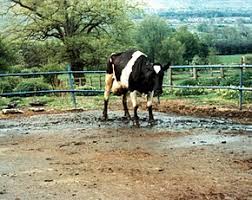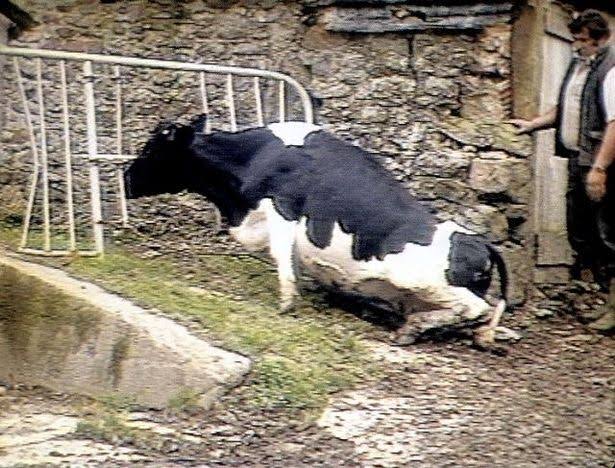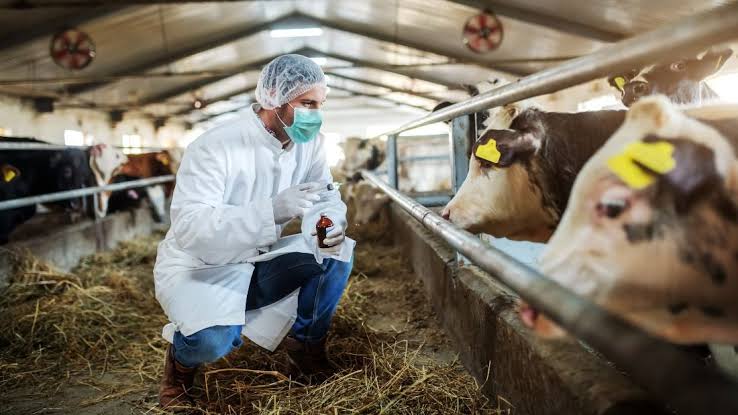Bovine spongiform encephalopathy (BSE), commonly known as Mad Cow Disease, is a serious condition affecting cattle. Its scientific name is Bovine Spongiform Encephalopathy, and it belongs to a group of diseases known as transmissible spongiform encephalopathies (TSEs). These diseases involve the accumulation of abnormal prion proteins in the brain, causing damage and leading to neurological symptoms.
Mad Cow Disease gained significant attention in the late 20th century due to its potential link to a variant of Creutzfeldt-Jakob disease (vCJD) in humans. The disease primarily affects cattle, impacting their nervous system and causing behavioral changes, difficulty in coordination, and, ultimately, severe neurological damage.
The origins of BSE are believed to be linked to the feeding practices of cattle. In the 1980s and 1990s, it was discovered that cattle were being fed with protein supplements derived from infected animals, leading to the spread of the abnormal prion proteins. This contaminated feed was a key factor in the outbreak of BSE.
The impact of BSE extends beyond the affected cattle population. Concerns arose about the potential transmission of the disease to humans through the consumption of contaminated beef products. This led to significant changes in agricultural and food safety practices to mitigate the risk of transmission to humans.
Governments and regulatory bodies implemented measures to control and prevent the spread of BSE. These measures included banning the use of certain animal-derived feedstuffs, implementing strict surveillance and testing programs, and imposing restrictions on the movement of cattle to prevent further outbreaks.
Research into prion diseases, including BSE, has advanced our understanding of these unique infectious agents. Prions are misfolded proteins that can induce the misfolding of normal proteins in the brain, leading to the formation of abnormal protein aggregates. The exact mechanisms of prion transmission and the development of the disease remain areas of active investigation.
The discovery of the link between BSE and vCJD in humans raised concerns about the potential for other zoonotic diseases, highlighting the interconnectedness of animal and human health. The global response to BSE emphasized the importance of surveillance, communication, and international collaboration in addressing emerging diseases that have the potential to affect both animal and human populations.
However, Bovine Spongiform Encephalopathy, commonly known as Mad Cow Disease, is a transmissible spongiform encephalopathy that affects cattle. Its impact on both animal and human health led to significant changes in agricultural and food safety practices. Ongoing research continues to enhance our understanding of prion diseases, contributing to the development of effective control measures to prevent future outbreaks.
Read Also: All You Need To Know About Mow Lawn Flowers
Animals Affected by Bovine Spongiform Encephalopathy

Bovine spongiform encephalopathy (BSE) primarily affects cattle. It is a neurodegenerative disease that targets the nervous system of bovines. The disease is characterized by the accumulation of abnormal prion proteins in the brain, leading to severe neurological damage.
While BSE primarily impacts cattle, there have been concerns about its potential transmission to other animals, including humans. The link between BSE and a variant of Creutzfeldt-Jakob disease (vCJD) in humans raised questions about zoonotic transmission. However, the evidence suggests that the risk of transmission to other animals is relatively low, and cases of BSE in non-bovine species are extremely rare.
The measures implemented to control and prevent the spread of BSE, such as changes in feed practices and surveillance programs, have contributed to minimizing the risk of transmission to other animals. Additionally, strict regulations on the processing and distribution of meat products aim to ensure that BSE-infected tissues are not introduced into the food chain.
However, while BSE primarily affects cattle, the risk of transmission to other animals, including humans, has been addressed through stringent measures and surveillance programs. The focus on preventing the spread of BSE has played a crucial role in safeguarding both animal and human health.
Damages Caused by Bovine Spongiform Encephalopathy

Bovine spongiform encephalopathy (BSE) causes significant damage primarily in affected cattle. The disease is characterized by the accumulation of abnormal prion proteins in the brain, resulting in severe neurological damage. Here are some of the damages caused by BSE:
1. Neurological Symptoms: BSE leads to a range of neurological symptoms in cattle, including behavioral changes, anxiety, aggression, and difficulty in coordination. Affected animals may exhibit abnormal movements and have trouble standing or walking.
2. Brain Damage: The abnormal prion proteins cause structural changes in the brain, leading to the formation of microscopic holes. This gives the brain a sponge-like appearance, which is characteristic of the disease.
3. Decline in Health: As the disease progresses, affected cattle experience a decline in overall health. They may lose weight, exhibit signs of distress, and suffer from a deterioration of bodily functions.
4. Impacts on Livestock Industry: BSE outbreaks have serious economic consequences for the livestock industry. The discovery of infected cattle can result in trade restrictions and the culling of affected herds, leading to financial losses for farmers and stakeholders.
5. Human Health Concerns: While BSE primarily affects cattle, its potential link to a variant of Creutzfeldt-Jakob disease (vCJD) in humans has raised significant public health concerns. Although the risk of transmission to humans is low, cases of vCJD have been associated with the consumption of BSE-contaminated meat products.
6. Regulatory and Trade Implications: The emergence of BSE has prompted governments and regulatory bodies to implement strict measures to control and prevent its spread. These include bans on certain feedstuffs, surveillance programs, and international trade restrictions on cattle and beef products.
7. Research and Surveillance Costs: The need for ongoing research, surveillance, and monitoring programs to detect and control BSE requires substantial financial resources. Governments and organizations invest in these efforts to safeguard public health and maintain the integrity of the livestock industry.
Bovine Spongiform Encephalopathy causes significant damages in affected cattle, impacting their neurological function, overall health, and the livestock industry. The potential implications for human health and the economic consequences have led to extensive regulatory measures and ongoing research efforts to mitigate the impact of this disease.
Read Also: All You Need To Know About Artificial Hanging Plants
Control and Preventive Measures

Control and preventive measures for Bovine Spongiform Encephalopathy (BSE) have been implemented globally to minimize the spread of the disease and mitigate its impact on both animal and human health. Here are some key measures:
1. Feed Regulations: Strict regulations have been established to control the content of animal feed, aiming to prevent the inclusion of proteins derived from ruminant tissues in cattle feed. This is crucial in limiting the transmission of BSE through contaminated feed.
2. Surveillance and Testing Programs: Countries with a history of BSE or those at risk implement surveillance and testing programs to detect the presence of the disease. This involves regular monitoring of cattle populations and testing brain tissues for the abnormal prion proteins.
3. Cattle Identification and Traceability: Systems for cattle identification and traceability are in place to track the movement of animals. This helps identify and control the spread of BSE by allowing authorities to trace the origin of infected animals and take appropriate measures.
4. Culling and Disposal: In the event of a confirmed BSE case, affected animals and those at risk may be culled to prevent further transmission. Proper disposal methods, such as incineration, are employed to minimize the risk of environmental contamination.
5. Trade Restrictions: International trade restrictions on cattle and beef products are implemented to prevent the spread of BSE across borders. Countries may impose import bans on cattle or beef from regions with confirmed cases of BSE.
6. Research and Surveillance Funding: Significant investments are made in research to better understand prion diseases, including BSE. This funding supports ongoing surveillance efforts, the development of diagnostic tools, and the exploration of potential control strategies.
7. Public Awareness and Education: Public awareness campaigns and educational initiatives aim to inform farmers, stakeholders, and the general public about the risks of BSE and the importance of complying with preventive measures. This helps create a collective effort in preventing the disease.
8. Continuous Risk Assessment: Authorities regularly conduct risk assessments to evaluate the potential for BSE transmission and adapt preventive measures accordingly. This includes reassessing feed regulations, surveillance strategies, and international collaboration.
9. Global Collaboration: Given the potential for BSE to have international implications, countries collaborate through organizations like the World Organisation for Animal Health (OIE) to share information, harmonize control measures, and collectively address the global challenge of prion diseases.
The control and preventive measures for BSE encompass a combination of regulatory, surveillance, and educational strategies. These efforts aim to reduce the risk of transmission, safeguard public health, and maintain the integrity of the livestock industry on a global scale.
Frequently Asked Questions (FAQs) About Bovine Spongiform Encephalopathy
Q1: What is Bovine Spongiform Encephalopathy (BSE)?
A1: Bovine Spongiform Encephalopathy, commonly known as Mad Cow Disease, is a neurodegenerative disorder that affects cattle. It is characterized by the accumulation of abnormal prion proteins in the brain, leading to severe neurological damage.
Q2: How is BSE transmitted?
A2: BSE is primarily transmitted through the ingestion of contaminated feed containing infected ruminant tissues. The abnormal prion proteins responsible for the disease can be present in the brain and spinal cord of infected cattle.
Q3: Can BSE be transmitted to humans?
A3: While the risk is low, there is a concern about the potential transmission of BSE to humans. A variant of Creutzfeldt-Jakob disease (vCJD) in humans has been linked to the consumption of BSE-contaminated meat products.
Q4: What are the symptoms of BSE in cattle?
A4: Cattle affected by BSE may exhibit behavioral changes, anxiety, aggression, and difficulty in coordination. Neurological symptoms progress, leading to severe damage to the nervous system.
Q5: How is BSE diagnosed in cattle?
A5: Diagnosis involves post-mortem examination of the brain tissues to detect the characteristic spongiform changes and the presence of abnormal prion proteins. Surveillance and testing programs are crucial for early detection.
Q6: What measures are in place to prevent BSE?
A6: Preventive measures include strict regulations on animal feed to prevent the inclusion of infected tissues, surveillance and testing programs, cattle identification and traceability, culling of affected animals, and international trade restrictions.
Q7: Can humans get BSE from consuming beef?
A7: While the risk is low, there have been cases of vCJD in humans linked to the consumption of BSE-contaminated meat products. Stringent measures in place aim to minimize this risk, including surveillance and strict regulations.
Q8: Are there any treatments for BSE?
A8: Currently, there is no cure or specific treatment for BSE. Prevention and control measures focus on minimizing the transmission of the disease and protecting both animal and human health.
Q9: How is BSE monitored globally?
A9: Global monitoring involves collaboration between countries through organizations like the World Organisation for Animal Health (OIE). Surveillance programs, research, and information sharing contribute to a collective effort in addressing BSE.
Q10: Is it safe to consume beef products now?
A10: With stringent preventive measures in place, including feed regulations, surveillance, and testing programs, the risk of consuming BSE-contaminated beef products is minimized. Authorities continuously monitor and adapt measures to ensure safety.
Read Also: A Guide to Waste Management Case Studies
